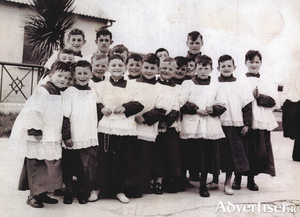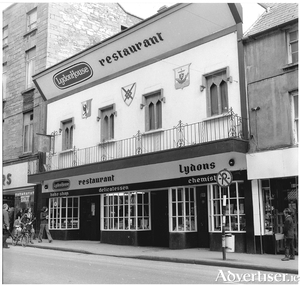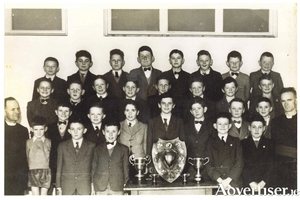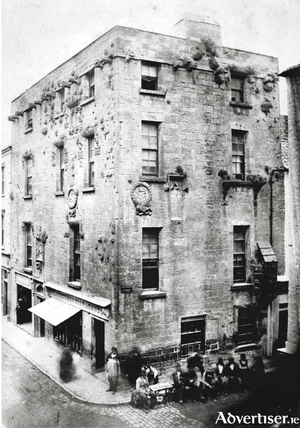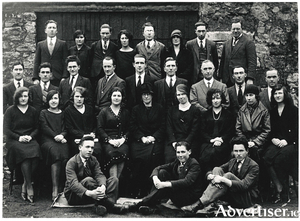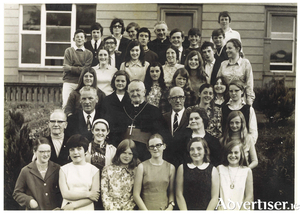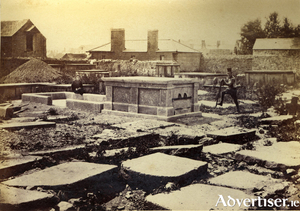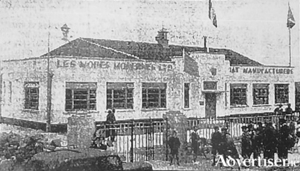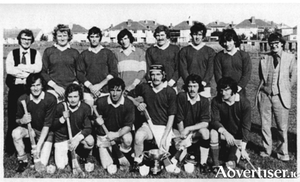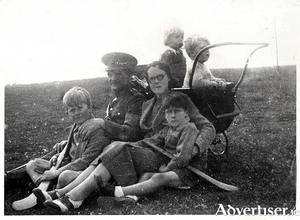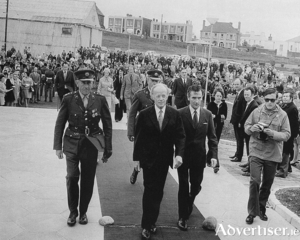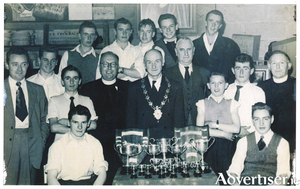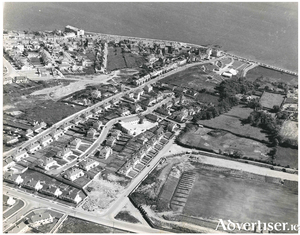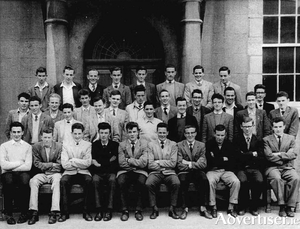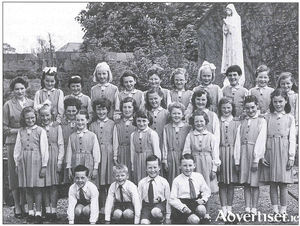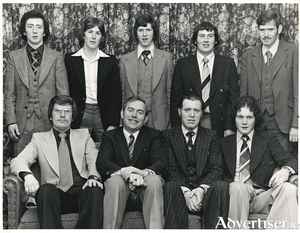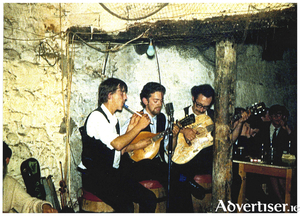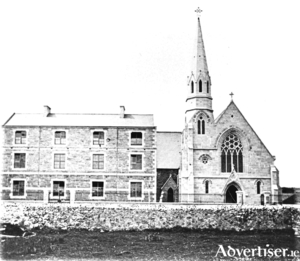Arms of the city
Thu, Sep 14, 2023
A coat of arms is described as a heraldic visual design on an escutcheon surcoat or tabard. The coat of arms on the escutcheon forms the central element of the full heraldic achievement which in its whole consists of a shield, supporters, a crest and a motto. A coat of arms is traditionally unique to the armiger.
Since its foundation in the early 13th century, the town of Galway has used at least five different coats of arms. The first three of these did not, as far as is known, belong to the town proper but were used by townspeople for official purposes in the absence of specific town arms.
Read more ...Saint Patrick’s Church
Thu, Sep 07, 2023
This photograph of St Patrick’s Church and part of Forster Street was taken from the Galway/Clifden Railway Line overlooking James Mahon’s Field where the circuses used to be long ago. It was taken c1920.
Read more ...Lydon’s restaurant
Thu, Aug 31, 2023
In October 1935, the local papers reported that Mr Thomas Lydon was about to open a super restaurant, installed with the latest conveniences, over his well-known confectionery shop on Shop Street. “A masterpiece of Modernity. Its equipment is the most up-to-date procurable including a Major ‘Esse’ Cooker, Electric Magrini Toaster, Scott Electric Hot Plate, Cold Storage room and a Frigidaire Ice Cream cabinet, The entrance to the restaurant is through the handsome shop premises which have also been modernized and where the aromas of freshly made bread buns and cakes was mouth-watering. The work of the restaurant, which could seat 200 people, is carried on by a well-trained staff of about thirty.”
Read more ...St Patrick’s National School
Thu, Aug 24, 2023
On January 15, 1827 two Patrician Brothers, Paul O’Connor and James Walsh, took up residence in Lombard Street and set up the Monastery School. The attendance on that first day was 300 boys, many of whom had little interest in learning because they were poor and hungry. So the Brothers set up The Poor Boy’s Breakfast Institute in May 1830. It continued seven days a week, 365 days a year for many years after the founders' time. The breakfast consisted of porridge with molasses or treacle, and during the Famine, they fed 1,000 boys every day. The ‘Old Mon’ became a vital cog in education in Galway.
Read more ...Lynch’s Castle
Thu, Aug 17, 2023
Lynch’s Castle is one of the finest surviving medieval townhouses, one of the best known examples of pre-Renaissance architecture in Ireland. It is essentially a two-period structure, the original 16th century castle was square in plan and was limited to the space now occupied on the ground floor by the vestibule of the bank. That portion to the west on Shop Street was added c1808. The extension is evident in the masonry of the exterior of the building, and the window hood-moulds of this section are very different in the character of their detail and carving from the original work. It is likely that the whole interior was remodelled and the storeys altered at this time, the window hood-moulds, the panels, the gargoyles, etc, being moved to their present positions.
Read more ...Frank McDonagh & Co
Thu, Aug 10, 2023
Frank McDonagh and Company were wholesale and retail drapers and outfitters that opened in Williamsgate Street in 1883. In early advertisements, they described themselves as “Successors to M. Hennessy, the house for original Claddagh cloaks as supplied to the Royal family”.
Read more ...Lifesaving in Galway
Thu, Aug 03, 2023
Organised water safety in Ireland really began in Milltown Malbay, Co Clare in the 1930s when a lady drowned there. This galvanised the local community into forming a Water Safety Association to help swimmers who got into trouble. The idea spread through Co Clare and eventually to the whole country. The national water safety section, set up by the government, was run by the Red Cross.
Read more ...St Augustine’s Fort/Forthill
Thu, Jul 27, 2023
The site of the Augustinian House when the order first came to Galway in 1508 was on the hill we know as Forthill today. Margaret Athy, the wife of the Mayor Stephen Lynch, invited them and she built a church and steeple there too. Her husband was away in Spain and got a shock when he returned to see the finished new building on the hill. The friars moved into a house within the walled city but their church was still between the city and the bay.
Read more ...The Hat Factory
Thu, Jul 20, 2023
In the 1930s, Ireland instructed all of its consul officials in Europe not to issue visas to Jewish refugees, but the country was also in a state of economic stagnation at the time and Seán Lemass realised that new industries would help the country. An Irish Jewish businessman, Marcus Witztum, offered to help him and went to Paris, met Henri Orbach there who owned a small hat factory and suggested he open a business in Ireland, a safer place for people of the Jewish persuasion than continental Europe. Orbach agreed.
Read more ...In memory of Criostóir
Thu, Jul 13, 2023
A ballad is a form of verse, a poem or a song that tells a story. It can be considered either poetic or musical and is written in short stanzas with a rhyming system abcb. These forms of folk songs were often anonymous retellings of local legends, stories of particular events or characters.
Read more ...Donal Mac Amhlaigh
Thu, Jul 06, 2023
Donal Mac Amhlaigh was born on Cappagh Road in Barna on December 10, 1926. His father James was a native of Kinvara who fought with the East Clare Brigade of the IRA in the War of Independence and who later joined the Irish Army. His mother was an Irish speaker, Mary Condon from Cappagh. They had three sons and a daughter in family. Pádraic Ó Conaire was a regular visitor to their house.
Read more ...Leisureland, fifty years old
Wed, Jun 28, 2023
The front page story on the first ever issue of the Galway Advertiser in 1970 was about the announcement of plans for a proposed new leisure centre to be situated between Revagh Road in Rockbarton and the Promenade.
Read more ...The Boy’s Club, 83 years old and still going
Thu, Jun 22, 2023
Our Lady's Boys Club was founded in 1940 by Fr. Leonard Shiel S.J. “to help young lads, flung into work at an early age when their characters are most easily formed for good or for ill. The Club hopes to play its small part in the present day effort all over Ireland to help poor boys to be more reliable and useful members of society and a credit to their faith”.
Read more ...Pearse Stadium, Páirc an Phiarsaigh
Thu, Jun 15, 2023
Sixty six years ago this week, on June 16 1957, Pearse Stadium opened.
Read more ...The Leaving Cert
Thu, Jun 08, 2023
The Leaving Certificate, also known as Gaeilge as the Árd Teist, was first established in this country in 1924 and the first papers were marked in 1925. It is the final examination in the secondary school system and also serves as the university matriculation exam. There was a time when these two were separate exams. It is for the senior school cycle, most of the participants are 16 to 19 years old, although an increasing number of mature student now sit the tests.
Read more ...Scoil Íde, seventy years a-growing
Thu, Jun 01, 2023
On this day 70 years ago, June 1 1953, Scoil Íde opened for the first time. In 1952, the Sisters of Jesus and Mary purchased Allen’s Hotel on Dalysfort Road which had been run by John and Angela Allen. It had at one time been known as Daly’s Fort House, a high-class hotel run by a Mrs Galbraith. She sold it to a Mr Miller of Persse’s Distillers who used it as a private house and he sold it on to the Allens. Many will remember it as the place where Bruce Woodcock, the English Heavyweight champion, trained for his famous fight with Máirtín Thornton.
Read more ...Tomás Bán and Helena Concannon
Thu, May 25, 2023
Tomás Bán and his wife Helena made an outstanding contribution to the cultural enrichment of Galway, and indeed of the country generally, in the first half of the last century.
Read more ...Of postmen and postwomen
Thu, May 18, 2023
The regular use of the words ‘litir’ and ‘post’ in 15th century Irish manuscripts suggests that by that time a postal system was already in existence in Ireland. The English postal system was completely reformed by a man named Witherings in 1638 and he was then invited to do the same in Ireland. By the 1650s, mail was being carried by post boys who walked 16 to 18 miles a day between towns. It is believed the Galway Post Office was set up in 1653 when the Cromwellians were still here. In those early years, the local postmaster was expected to provide the premises, so every time a new postmaster was appointed, it meant a new main Post Office.
Read more ...'It was in the air'
Thu, May 11, 2023
Prior to 1961, public performance of Irish traditional music in Galway took place primarily in the form of céilís in large dancehalls — namely in the Hangar, the Commercial and the Astaire. These were enormously popular — remember the hundreds of bicycles parked outside the Hangar on a Sunday night — but they began to go out of fashion in the sixties and were regarded as old fashioned and backward.
Read more ...The Jesuits in Galway
Thu, May 04, 2023
There is historical evidence to show that the Jesuits were already in the city in the early 1600s, combining the work of ministry and education. In 1645, the Order set up their first college in Galway on Lower Abbeygate Street, where Powell’s shop is today. They were forced to leave the city by the Cromwellians, but they came back. They were forced to leave the city by the Williamites, but they came back. They had to close their Galway residence in 1768 due to a lack of manpower but they were persistent and came back again, and in 1859 they took over a house on Prospect Hill and the following year, set up a college in Eyre Square.
Read more ...